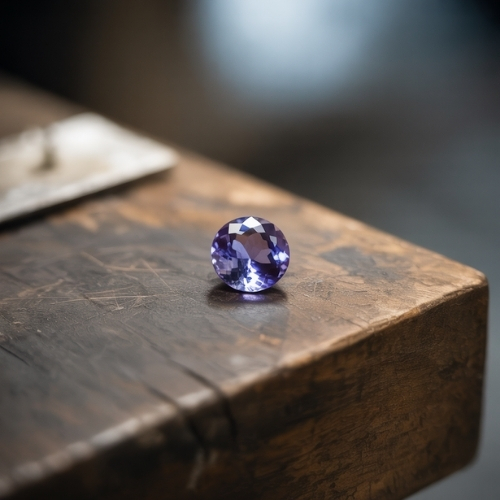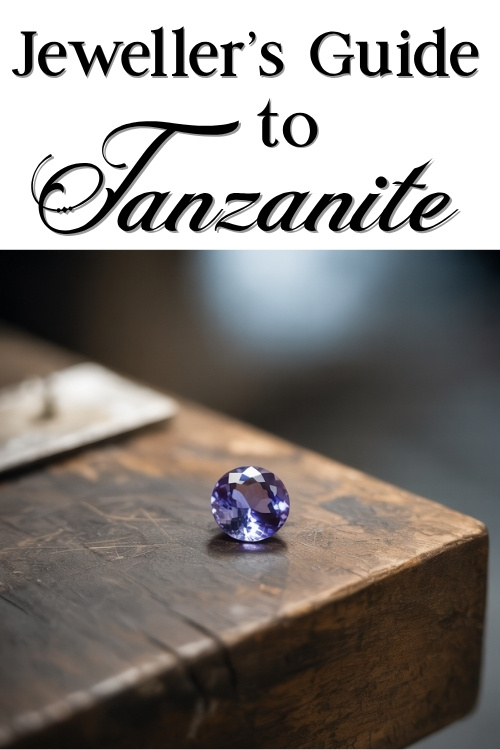Beloved for its vivid violet-blue hues and fascinating optical effects, tanzanite is a relatively new gemstone on the scene, but it has already made a big impression. First discovered in the 1960s in a single location in Tanzania, this gem quickly gained popularity and was even declared an official birthstone in the early 2000’s. With its rare origin and complex beauty, tanzanite brings both elegance and intrigue to any jewellery design.
Basic Identification Information
Name & Synonyms
Tanzanite (occasionally referred to by its mineral name, zoisite, though rarely in jewellery contexts)
Species
Zoisite
Colour Range
Most prized for deep violet-blue, though colours range from blue to bluish purple to violet.
Refractive Index
1.686 – 1.705
Birefringence
0.008 – 0.013
Optical Sign
Biaxial positive
Pleochroism
weak to strong and 3 colours.
Deep blue, purple, and green or Deep blue, purplish red, and greenish yellow or Reddish purple, blue, and yellowish brown
Specific Gravity
3.35
Fluorescence
None
Lustre
Vitreous (glass-like)
Clarity
Type I
Stones are typically eye clean, but feather and needle inclusions can appear in lower grades.
Gems Often Mistaken For
Iolite, Sapphire, Spinel
Mohs Hardness
6 to 7
Wearability
Fair to good.
Birthstone
December (along with zircon and turquoise)
Spotting Synthetic (Lab-Grown) Tanzanite
To date, there are no known synthetic tanzanites available on the commercial market. However, imitations are relatively common, especially coloured glass and synthetic materials, such as cubic zirconia, that have been designed to mimic tanzanites signature colour.
Common Treatments
Nearly all tanzanite sold today has been heat-treated to improve its colour. The heating process removes brownish overtones and brings out the vibrant blue-violet tones that the gem is known for.
This treatment is stable and widely accepted in the industry, though it should always be disclosed. Naturally vivid blue tanzanite does occur, but it is extremely rare and commands significantly higher prices.
Durability & Setting Considerations
Tanzanite’s beauty comes with a degree of fragility. With a hardness between 6 and 7 and distinct cleavage planes, it’ i’s more prone to scratches than many popular gemstones and more vulnerable to knocks or pressure at specific angles.
It’s particularly well suited to earrings and pendants, which are less exposed to impact than rings.
For rings or bracelets, settings should offer added protection. Bezel settings are an excellent choice for daily wear designs, while halos can provide both structural and visual benefits.
During the setting process, jewellers should avoid applying pressure to the edges or corners of the stone, as these are points where cleavage fractures can occur.
Tanzanite is also heat-sensitive. It’s best to avoid soldering near a set stone or exposing it to direct flame. Ideally, all high-heat work should be completed before setting the gem. If adjustments are necessary afterward, heat sinks should be used to reduce the risk of thermal shock.
Care Instructions
Cleaning
Tanzanite should always be cleaned gently. Warm, soapy water and a soft brush are the safest methods. Ultrasonic and steam cleaners should be avoided, as the gem is too delicate for aggressive cleaning.
Storage
Store tanzanite separately from harder gemstones like quartz, spinel, or sapphire. Wrap it in soft cloth or place it in a padded compartment to prevent surface scratches.
Daily Wear
While tanzanite makes beautiful jewellery, it isn’t ideal for everyday rings or high-contact pieces. It’s best suited to occasional wear or pieces worn in low-impact settings. Educating clients about the gem’s limitations helps ensure long-term satisfaction and care.
Market & Ethical Notes
Tanzanite is one of the most geographically restricted gemstones in the world. All known supply comes from a small mining area in northern Tanzania. This limited origin enhances its rarity but also means the market is susceptible to supply fluctuations and changing export laws.
In recent years, the Tanzanian government has tightened export controls, encouraging more value-added work, such as cutting and polishing, to happen locally. These policies aim to increase economic benefit within Tanzania and preserve the stone’s value.
Ethical sourcing is especially important when buying tanzanite. Where possible, seek out suppliers who are transparent about their supply chain and actively support fair labour and community-focused initiatives in the mining region.
Symbolic & Spiritual Meanings
Despite its relatively recent discovery, tanzanite has gained a strong following in metaphysical circles. It is often associated with transformation, spiritual growth, and intuitive insight.
The stone has been linked to the third eye and crown chakras, making it a popular choice for those seeking deeper awareness or emotional clarity.
🔗 Dive deeper into Tanzanite’s Symbolic & Spiritual Meanings
Etymology
The name “tanzanite” was coined by Tiffany & Co. in 1967, shortly after the gem’s discovery. Initially known as “blue zoisite,” the name was changed for marketing purposes, specifically to avoid zoisite which has a similar sound to the word suicide. Tiffany’s renaming not only solved a branding issue but also gave the gem a strong identity rooted in its country of origin.
🔗Curious about how tanzanite was viewed in ancient cultures? Explore its fascinating myths and legends (coming soon)
📌 Save this jeweller’s guide to tanzanite for quick reference next time you’re working with this stunning gem.


